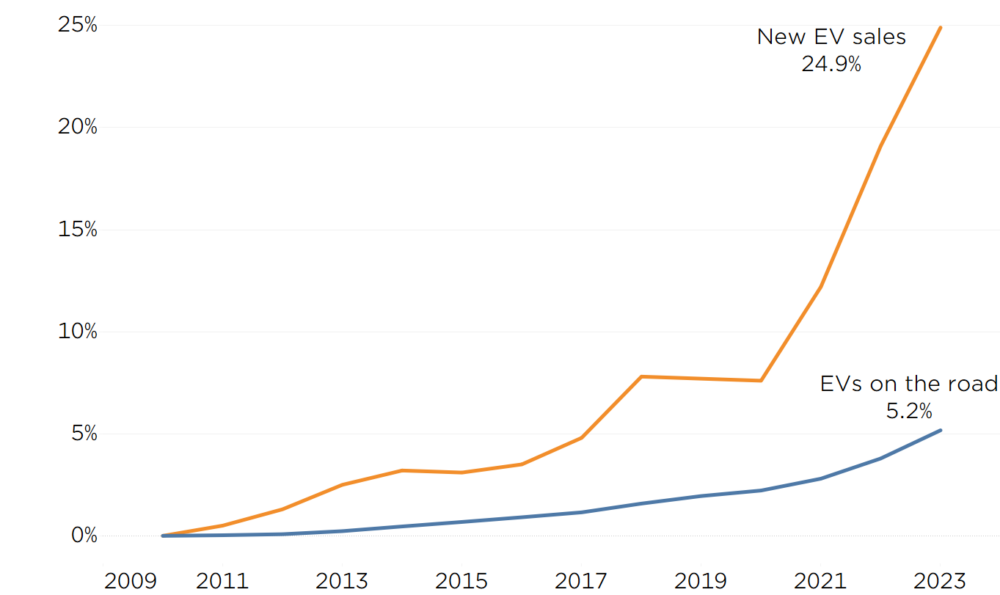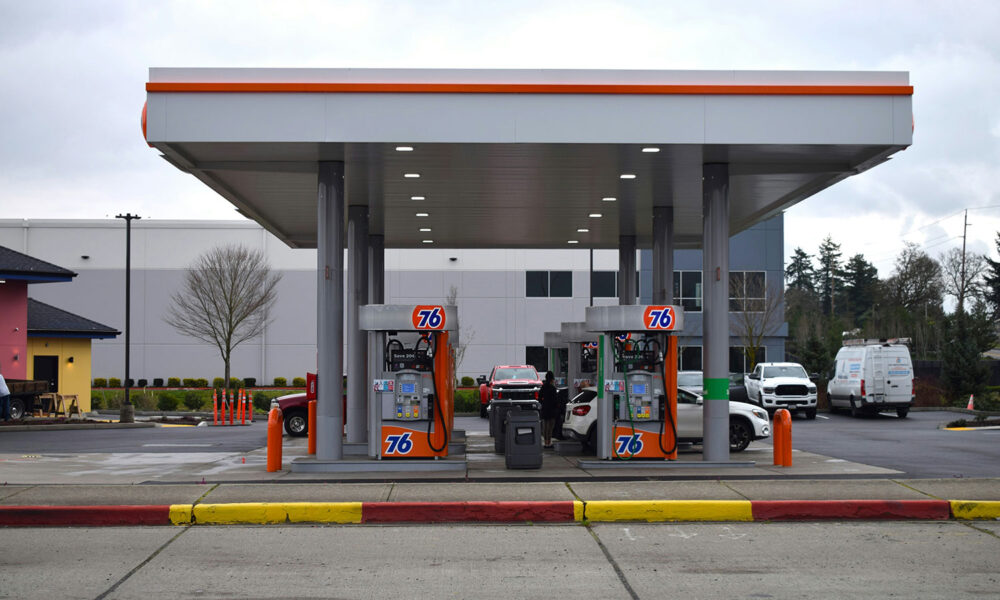Despite adding six million more passenger cars, trucks, and SUVs to the roads over the last 10 years, California’s gasoline consumption has dropped over two billion gallons from its peak in 2005. More efficient (and cleaner) gasoline cars are part of the reason why gasoline use is down, but the increasing number of electric vehicles being sold in the state will likely drive gasoline use down even further.
Switching from fossil fuels like gasoline to increasingly clean electricity sources is vital for hitting climate and air pollution goals. This trend is clear, but this transition away from petroleum needs to speed up to reduce emissions as fast as possible. At the same time, we need to be intentional about how we phase out gasoline production so that the people and communities that are impacted by oil production and refining can plan for this future. Phasing out the use of gasoline is a great opportunity but also beings some real challenges, and we need to plan and implement the phaseout of petroleum with care to protect workers, communities and consumers from bad behavior from the oil industry.

Gasoline use in 2023 in California dropped about 15 percent from a peak in 2005, with consumption dropping over two billion gallons per year

Annual gasoline consumption per person in California has also dropped, from almost 450 gallons per year per person to below 350 gallons per person. To meet emissions goals and avoid the worst impacts of climate change, this trend will need to accelerate over the coming decades.
Number of cars are up, but gasoline use is down
The number of passenger cars, trucks, and SUVs in California has continued to increase over the last ten years, from less than 23 million in 2013 to almost 29 million in 2023. But even though we’ve added six million passenger cars to the road in the last 10 years, gasoline use has dropped. Gasoline consumption is down by more than two billion gallons per year since 2017, when 15.6 billion gallons were sold in the state. Gasoline use per person has also fallen, from 445 gallons per year per person in 2005, to under 350 gallons per year per person in 2024.

Electric vehicles made up five percent of passenger vehicles on the road in 2023 and the fraction is growing with EVs making up 25 percent of new passenger vehicles sold in the state.
While we can’t attribute this reduction in gasoline use to any one factor, we know that major factors are the miles being driven in gasoline vehicles, the fuel economy of these gasoline-powered vehicles, and the displacement of gasoline vehicles with electric cars and trucks. The dip in gasoline use in 2020 was due to the reduction in personal vehicle use during the initial phases of the coronavirus pandemic. However the long term drop in per person gasoline use is likely due to fuel economy and greenhouse gas standards that have made gasoline vehicles more efficient over the prior decades. These regulations (both state and federal) that UCS has advocated for have saved drivers money and reduced emissions.
But a growing share of the reductions is likely due to the increasing sales of electric vehicles (EVs). Only around 50,000 EVs were on the road in 2013, but there are now over 1.5 million EVs in use in California, making up five percent of the passenger vehicles on the road. And over one million of the EVs are battery electric vehicles that use no gasoline (with the remaining EVs being plug-in hybrids). Based on the average per vehicle gasoline consumption, EVs are displacing over a half a billion gallons of gasoline per year in California. And with sales of EVs now at 25 percent of all new passenger vehicles in the state, the contribution to reduced gasoline consumption from EVs will continue to grow. There is a considerable lag between the growth in new EV sales and the fraction of vehicles on the road that are electric, but we know that if EV sales continue to grow that reductions in gasoline use will follow.
Benefits of cutting gasoline use
Reducing gasoline consumption has several benefits, chiefly the reduction in tailpipe emissions that lead to both climate change and poor air quality.
Burning gasoline in an automobile produces carbon dioxide, the primary cause of climate change. Each gallon of gasoline used results in 19 pounds of carbon dioxide emissions to the atmosphere, and the extraction of oil, refining, and distribution of gasoline results in the equivalent of an additional 4.5 pounds of carbon dioxide emissions per gallon. While generating electricity to recharge an electric vehicle also produces emissions, they are much lower than those from gasoline, especially when recharging on California’s increasingly clean grid. Using the average EV on California’s grid results in emissions equal to a hypothetical 137 mpg gasoline car. That’s less than a quarter of the emissions per mile of the average gasoline car on the road in California (29 mpg).
Eliminating gasoline combustion also means getting rid of harmful pollutant emissions like nitrogen oxides and reactive organic gases. Emissions of these pollutants lead to the formation of fine particulate matter, an air pollutant with significant public health harm.
Planning for the phase-out of gasoline
As the number of EVs on the road increase and replace gasoline cars and trucks, demand for gasoline
will fall at an accelerating rate as EVs replace gasoline cars and the EV share of the fleet grows. Declining gasoline consumption means big changes for the fuel sector, from oil extraction to refining and fuel distribution. These changes could increase the market power of a few big oil refiners, so stronger oversight and regulation is necessary to avoid anti-competitive behavior that harms consumers. Declining gasoline sales will also impact workers and communities, so the state needs to plan for a safe and fair petroleum phaseout that protects workers and communities and ensures a reliable supply of fuel is available to people who need it. UCS is participating in the Transportation Fuels Transition Plan working group, which is part of the implementation of Senate Bill X1-2 (California Gas Price Gouging and Transparency Law) that was enacted last year. If thoughtfully prepared in inclusive processes, this planning will be key to making this essential transition equitable and safe.
Accelerating the transition
While this trend of lower gasoline use in California is a step in the right direction, we need to move as fast as possible to reduce emissions to limit the damage from climate change. The state’s new vehicle regulations that require all new vehicles sold in 2035 to be zero emission vehicles will help drive down gasoline use (and emissions), but that’s a floor not a ceiling for what we can do. Incentives for replacing gasoline vehicles are also important, as is increasing the amount and availability of charging stations in the state. Switching from gasoline to electricity as quickly as possible is what we need to do, and that means both planning for many more EVs and the phase out of gasoline at the same time.

